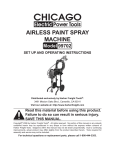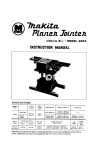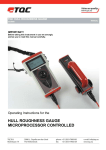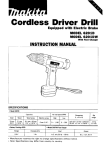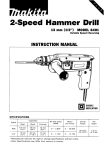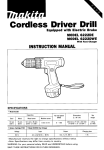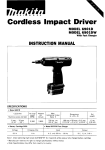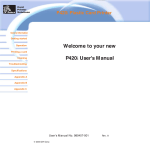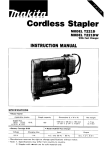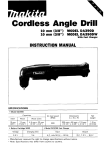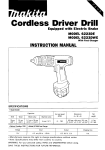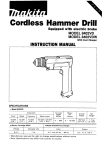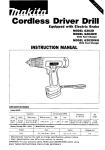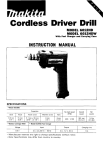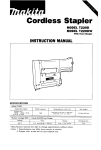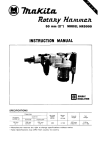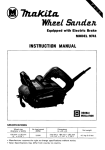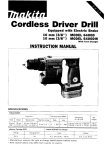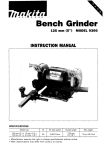Download Makita 6703D User's Manual
Transcript
Equipped with Electric Brake MODEL 6703D MODEL 6703DW With Fast Charger INSTRUCTION MANUAL SPECIFICATI0 NS Capacities Bolt, nut and machine screw size 3 mm 5 mm (1/8" - 3/16") ~ Battery Cartridge 9100 No load speed IRPM) Fastening torque Overall length Net weight 400 5 kg.cm - 37 kg.cm (0.4 ft.lbs - 2.7 ft.lbsl 333 mm (13-118") 1.3 kg (2.9 Ibs) Model DC9700 Fast Charger Voltage Input output 9.6 V A.C. only 50 Hz - 6 0 Hz D.C. 7.2 V, 9.6 V * Manufacturer reserves the right to change specifications without notice. Note: Specifications may differ from country t o country. WARNING: For your personal safety, READ and UNDERSTAND before using SAVE THESE INSTRUCTIONS FOR FUTURE REFERENCE. Charging time I 1 Hr. IMPORTANT SAFETY INSTRUCTIONS (For All Tools) WARNING: WHEN USING ELECTRIC TOOLS, BASIC SAFETY PRECAUTIONS SHOULD ALWAYS BE FOLLOWED TO REDUCE THE RISK OF FIRE, ELECTRIC SHOCK, AND PERSONAL INJURY, INCLUDING THE FOLLOWING: READ ALL INSTRUCTIONS. 1. KEEP WORK AREA CLEAN. Cluttered areas and benches invite injuries. 2. CONSIDER WORK AREA ENVIRONMENT. Don't use power tools in damp or wet locations. Keep work area well lit. Don't expose power tools t o rain. Don't use tool in presence of flammable liquids or gases. 3. KEEP CHILDREN AWAY. All visitors should be kept away from work area. Don't let visitors contact tool or extension cord. 4. STORE IDLE TOOLS. When not in use, tools should be stored in dry, and high or locked-up place - out of reach of children. 5. DON'T FORCE TOOL. It will do the job better and safer at the rate for which it was intended. 6. USE RIGHT TOOL. Don't force small tool or attachment t o do the job of a heavy-duty tool. Don't use tool for purpose not intended; for example, don't use circular saw for cutting tree limbs or logs. 7. DRESS PROPERLY. Don't wear loose clothing or jewelry. They can be caught in moving parts. Rubber gloves and non-skid footwear are recommended when working outdoors. Wear protective hair covering t o contain long hair. 8. USE SAFETY GLASSES. Also use face or dust mask if cutting operation is dusty. 9. DON'T ABUSE CORD. Never carry tool by cord or yank it t o disconnect from receptacle. Keep cord from heat, oil, and sharp edges. IO. SECURE WORK. Use clamps or a vise t o hold work. It's safer than using your hand and it frees both hands to operate tool. 1 1 . DON'T OVERREACH. Keep proper footing and balance at all times. 12. MAINTAIN TOOLS WITH CARE. Keep tools sharp and clean for better and safer performance. Follow instructions for lubricating and changing accessories. Inspect tool cords periodically and if damaged, have repaired by authorized service facility. Inspect extension cords periodically and replace if damaged. Keep handles dry, clean, and free from oil and grease. 13. DISCONNECT TOOLS. When not in use, before servicing, and when changing accessories, such as blades, bits, cutters. 2 14. REMOVE ADJUSTING KEYS AND WRENCHES. Form habit of checking t o see that keys and adjusting wrenches are removed from tool before turning it on. 15. AVOID UNINTENTIONAL STARTING. Don't carry tool with finger on switch. Be sure switch is OFF when plugging in. 16. EXTENSION CORDS. Make sure your extension cord is in good condition. When using an extension cord, be sure t o use one heavy enough t o carry the current your product will draw. An undersized cord will cause a drop in line voltage resulting in loss of power and overheating. Table 1 shows the correct size t o use depending on cord length and nameplate ampere rating. If in doubt, use the next heavier gage. The smaller the gage number, the heavier the cord. TABLE 1 I 1 MINIMUM GAGE FOR CORD SETS Total Length of Cord in Feet 0 - 25 26 - 50 Ampere Rating More Not More Than Than 0 6 10 12 - 6 10 12 16 1 51 - 100 1 101 - 150 AWG 18 18 16 14 16 16 16 12 ;: 1 14 12 14 12 Not Recommended 17. OUTDOOR USE EXTENSION CORDS. When tool is used outdoors, use only extension cords intended for use outdoors and so marked. 18. STAY ALERT. Watch what you are doing, use common sense. Don't operate tool when you are tired. 19. CHECK DAMAGED PARTS. Before further use of the tool, a guard or other part that is damaged should be carefully checked t o determine that it will operate properly and perform its intended function. Check for alignment of moving parts, binding of moving parts, breakage of parts, mounting, and any other conditions that may affect its operation. A guard or other part that is damaged should be properly repaired or replaced by an authorized service center unless otherwise indicated elsewhere in this instruction manual. Have defective switches replaced by authorized service center. Don't use tool if switch does not turn it on and off. 20. GUARD AGAINST ELECTRIC SHOCK. Prevent body contact with grounded surfaces. For example; pipes, radiators, ranges, refrigerator enclosures. 21 . REPLACEMENT PARTS. When servicing, use only identical replacement parts. 22. POLARIZED PLUGS. To reduce the risk of electric shock, this equipment has a polarized plug (one blade is wider than the other). This plug will fit in a polarized outlet only one way. If the plug does not fit fully in the outlet, reverse the plug. Ifit still does not fit. contact a qualified electrician t o install the proper outlet. Do not change the plug in any way. 3 VOLTAGE WARNING: Before connecting the tool t o a power source (receptacle, outlet, etc.) be sure the voltage supplied is the same as that specified on the nameplate of the tool. A power source with voltage greater than that specified for the tool can result in SERIOUS INJURY t o the user - as well as damage t o the tool. If in doubt, DO NOT PLUG IN THE TOOL. Using a power source with voltage less than the nameplate rating is harmful t o the motor. 4 IMPORTANT SAFETY INSTRUCTIONS FOR CHARGER & BATTERY CARTRIDGE 1. SAVE THESE INSTRUCTIONS - This manual contains important safety and operating instructions for battery charger. 2. Before using battery charger, read all instructions and cautionary markings on (11 battery charger, (2) battery, and (3)product using battery. 3.CAUTION - To reduce risk of injury, charge only MAKITA Battery Cartridge 9100, 9100A. 9101 81 9101A. Other types of batteries may burst causing personal injury and damage. 4.Do not expose charger t o rain or snow. 5. Use of an attachment not recommended or sold by the battery charger manufacturer may result in a risk of fire, electric shock, or injury t o persons. 6. To reduce risk of damage t o electric plug and cord, pull by plug rather than cord when disconnecting charger. 7. Make sure cord is located so that it will not be stepped on, tripped over, or otherwise subjected t o damage or stress. 8. An extension cord should not be used unless absolutely necessary. Use of improper extension cord could result in a risk of fire and electric shock. If extension cord must be used, make sure: a. That pins on plug of extension cord are the same number, size, and shape as those of plug on charger; b. That extension cord is properly wired and in good electrical condition; and c. That wire size is at least as large as the one specified in the table below. TABLE 1 RECOMMENDED MINIMUM AWG SIZE FOR EXTENSION CORDS FOR BATTERY CHARGERS Length of Cord (Feet) 25 50 100 150 AWG Size of Cord 18 18 18 16 9. mediately. I O . Do not operate charger if it has received a sharp blow, been dropped, or otherwise damaged in any way; take it t o a qualified serviceman. 11. Do not disassemble charger or battery cartridge; take it t o a qualified serviceman when service or repair is required. Incorrect reassembly may result in a risk of electric shock or fire. 12. To reduce risk of electric shock, unplug charger from outlet before attempting any maintenance or cleaning. Turning off controls will not reduce this risk. 5 ADDITIONAL SAFETY RULES FOR CHARGER & BATTERY CARTRIDGE 1. Do not charge Battery Cartridge when temperature is BELOW 10°C (5OOF) or ABOVE 4OoC (104OF). 2. Do not attempt t o use a step-up transformer, an engine generator or DC power receptacle. 3.Do not allow anything t o cover or clog the charger vents. 4. Always cover the battery terminals with the battery cover when the battery cartridge is not used. 5. A battery short can cause a large current flow, overheating, possible burns and even a breakdown. (1) Do not touch the terminals with any conductive material. (2) Avoid storing battery cartridge in a container with other metal objects such as nails, coins, etc. (3)Do not expose battery cartridge t o water or rain. 6. Do not store the tool and Battery Cartridge in locations where the temperature may reach or exceed 5OoC (122OF). 7. Do not incinerate the Battery Cartridge even if it is severely damaged or is completely worn out. The battery cartridge can explode in a fire. ADDITIONAL SAFETY RULES FOR CORDLESS SCREWDRIVER 1. Be aware that this tool is always in an operating condition, because it does not have t o be plugged into an electrical outlet. 2. Always be sure you have a firm footing. Be sure no one is below when using the tool in high locations. 3.Hold the tool firmly. 4. Keep hands away from rotating parts. 5. When driving into walls, floors or wherever "live" electrical wires may be encountered, DO NOT TOUCH ANY METAL PARTS OF THE TOOL! Hold the tool only by the insulated grasping surfaces t o prevent electric shock if you drive into a "live" wire. 6. Do not touch the bit or the workpiece immediately after operation; they may be extremely hot and could burn your skin. SAVE THESE INSTRUCTIONS. 6 Installing or removing the battery cartridge Always switch off the tool before insertion or removal of the battery cartridge. To remove the battery cartridge, pull out the set plate on the tool and grasp both sides of the cartridge while withdrawing it from the tool. To insert the battery cartridge, align the tongue on the battery cartridge with the groove in the housing and slip it into place. Snap the set plate back into place. Be sure to close the set plate fully before using the tool. Battery cartridge I’ Set plate Do not use force when inserting the battery cartridge. If the cartridge does not slide in easily, it is not being inserted correctly. Charging Plug the fast charger into your power source. Insert the battery cartridge so that the plus and minus terminals on the battery cartridge Charging light are on the same sides as their respective Start button markings on the fast charger. Insert the Reset button cartridge fully into the port so that it rests on the charger port floor. Press the start button (red). The charging light will come on and charging will begin. If the charging light does not come on, press the reset button (yellow) first, then the start button (red). If the charging light goes out within 10 seconds even after pressing the reset button and start button a couple of times, the battery cartridge is dead. (CAUTION: Wait for more than 5 seconds after the charging light goes out to press the reset button again.) Replace it with a new one. When the charging light goes out in a certain time, you may remove the fully charged battery cartridge. Refer to the table below for the charging time. Fast charger DC9700 DC1201 DC9015 DC9112 Approx. 45 min. Approx. 15 min. Approx. 60 min. Approx. 60 min. - - Battery cartridge 9100, 9100A 9101, 9101A Approx. 60 min. ~~ 7 When you charge a new battery cartridge or a battery cartridge which has not been used for a long period, it may not accept a full charge. This is a normal condition and does not indicate a problem. You can recharge the battery cartridge fully after discharging it completely a couple of times. If you try t o charge a cartridge from a just-operated tool, sometimes the charging light will not come on. If this occurs, let the cartridge cool off for a while. Then re-insert it and try to charge it once more. Do not keep the button pressed in with tape, etc. or the circuit will not function properly. Also, a malfunction of the charger may result possibly causing overheating, etc. If you wish to charge t w o battery cartridges, allow 15 minutes between chargings on the fast charger. Installing or removing the bit CAUTIO N: Always be sure that the tool is switched off and the battery cartridge is removed before installing or removing the bit. Use only the driver bit or socket bit shown at right. Do not use any other driver bit or socket bit. 11 mm 4 9 mm (3/8") To install the bit, pull the sleeve in the direction of the arrow and insert the bit into the sleeve as far as it will go. Then release the sleeve t o secure the bit. I I 7 Bit Sleeve To remove the bit, pull the sleeve in the direction of the arrow and pull the bit out firmly. NOTE: If the bit is not inserted deep enough into the sleeve, the sleeve will not return t o its original position and the bit will not be secured. In this case, try re-inserting the bit according to the instructions above. 8 Switch action To start the tool, simply pull the trigger. Release the trigger to stop. CAUTIO N: Before inserting the battery cartridge into the tool, always check to see that the switch trigger actuates properly and returns to the "OFF" position when released. Reversing switch action This tool has a reversing switch to change Reversing switch the direction of rotation. Slide the reversing switch up for clockwise rotation or slide it down for counterclockwise rotation. Clockwise rotation 1 Counterclockwise Switch trigger CAUTION: Always check the direction of rotation before operation. Use the reversing switch only after the tool comes to a complete stop. Changing the direction of rotation before the tool stops may damage the tool. Overload protector The overload protector automatically cuts out to break the circuit whenever heavy work is prolonged. Wait 20 - 30 seconds before resuming operation. 9 Adjusting the fastening torque The fastening torque can be adjusted infinitely from approx. 5 kg . cm (0.4ft . Ibs) to 37 kg . cm (2.7 ft . Ibs). To adjust it, loosen the two screws and turn the adjusting ring. Then tighten the screws to secure the adjusting ring. Refer to the table below fok relation between the numbers on the adjusting ring and the fastening torque to be obtained. Red mark -Adjusting ring Screw Number Numbers on adjusting ring Fastening torque to be obtained 5 kg . cm (0.4 ft . Ibs) 1 I I 2 10 kQ . cm ( 0 . 7 ft . Ibs) 3 18 kg . cm (1.3 ft . Ibs) 4 2 7 kg . cm ( 2 . 0 ft . lbsl 5 3 7 kg . cm ( 2 . 7 ft . Ibs) I (Example) 10 kg . cm (0.7 f t . Ibs) of fastening torque can be obtained when the number 2 is aligned to the red mark. NOTE: Always tighten the two screws to secure the adjusting ring after adjusting the fastening torque. Operation The proper fastening torque may differ depending upon the kind or size of screws, the type of materialsto be fastened, the condition of the threads, etc. Before starting your job, always perform a test operation to verify adequate fastening torque. Hold the tool firmly and place the point of the driver bit in the screw head. Apply forward pressure to the tool to the extent that the bit will not slip off the screw and turn the tool on. As soon as the screw becomes tight, the clutch will cut in and the motor will stop automatically. Release the trigger. NOTE: Hold the tool pointed straight at the screw, or the screw and/or bit may be damaged. If the motor will not start even after you pull the trigger, release the trigger. Then pull the trigger again after turning the bit slightly with your fingers. Fastening performance The following reference table indicates the approximate fastening capacity from a single Screw size I 10 M 5 x 14 Fastenings Fastening torque I 5 I Approx. 7 0 0 screws I MAINTENANCE CAUTION : Always be sure that the tool is switched off and the battery cartridge is removed before attempting to perform inspection or maintenance. To maintain product SAFETY and RELIABILITY, repairs, maintenance or adjustment should be performed by Makita Authorized or Factory Service Centers, always using Makita replacement parts. 11 ACCESSORIES CAUTION: These accessories or attachments are recommended for use w i t h your Makita tool specified in this manual. The use,of any other accessories or attachments might present a risk of injury t o persons. The accessories or attachments should be used only in the proper and intended manner. Fast charger Charger 1 2 V for car Model DC9700 Model DC9112 Part No. 113103-2 Part No. 113110-5 9 Fast charger Model DC9015 Part No. 1 13106-6 Battery cartridge 9 1 00 Battery cover Plastic carrying case Part No. 192019-4 Part No. 414938-7 Part No. 182439.0 High capacity battery 9101 Power display battery (High cap1 9 1 0 0 A . 9 1 0 1 A Fast charger Model DC1201 9 Bit I Size Part No. Slotted Square drill bit 12 784606-0A Sep.--29-'94 US CORDLESS SCREWDRIVER Model 67031) Note: The switch and other part configurations may differ from country to country. 13 MODEL 6 7 0 3 D $2D Sep-29-'94 $zD DESCRIPTION DESCRIPTION ~ 1 2 3 4 5 6 7 8 9 10 11 12 13 14 15 16 17 18 19 20 21 22 23 24 25 26 27 1 1 1 1 2 1 1 1 1 1 1 1 1 1 2 1 1 1 1 1 1 1 1 1 1 1 1 Ring Spring 1 1 Flat Washer 12 Compression Spring 13 Sleeve Steel Ball 3 5 Spindle Key 4 Retaining Ring 5 - 3 4 Flat Washer 3 4 Head Flat Washer 10 Ball Bearing 6000LLB Flat Washer 1 0 Retaining Ring S - 1 0 Screw M 4 x 6 Change Ring Slide Plate Compression Spring 18 Compression Spring 13 Lock Sleeve DC Motor 9.6 V Flat Washer 12 Internal Gear 67 Spur Gear 28 Ring 1 8 Spur Gear 28 Spur Gear 11 28 29 30 31 32 33 34 35 36 37 38 39 40 41 42 43 44 45 46 47 48 49 50 1 1 1 1 1 2 1 2 1 1 1 2 1 1 1 1 1 1 1 1 1 1 1 I !i I ; I i 5 1 1 1 Note: The switch and other part specifications may differ from country to country. 14 Spur Gear 28 Spur Gear 28 Plate IUI Plate Lock Washer 1 0 Spring Pin 3 - 6 Holder Steel Ball 6 Retainer Thrust Needle Gauge 1224 Flat Washer 12 PI" 4 Spur Gear 28 Spur Gear 28 Housing Set lWith Item 541 Name Plate 8" 9100 Battery Holder set Plate Compresslo" Spring 4 Switch Lever Switch Switch LWW Compression Spring 2 Pan Head Screw M4x22 IWlth Washer1 Housing Set (With Item 421 US Recycling the Battery The only way to dispose of a Makita battery is to recycle it. The law prohibits any other method of disposal. I Ni-Cd I To recycle the battery: 1. Remove the battery from the tool. 2. a). Take the battery to your nearest Makita Factory Service Center or b). Take the battery to your nearest Makita Authorized Service Center or Distributor that has been designated as a Makita battery recycling location. Call your nearest Makita Service Center or Distributor to determine the location that provides Makita battery recycling. See your local Yellow Pages under ”Tools-Electric’ I MAKITA LIMITED ONE YEAR WARRANTY Warranty Policy Every Makita tool is thoroughly inspected and tested before leaving the factory. It is warranted t o be free of defects from workmanship and materials for the period of ONE YEAR from the date of original purchase. Should any trouble develop during this one-year period, return the COMPLETE tool, freight prepaid, to one of Makita’s Factory or Authorized Service Centers. If inspection shows the trouble is caused by defective workmanship or material, Makita will repair (or at our option, replace) without charge. This Warranty does not apply where: e repairs have been made or attempted by others: repairs are required because of normal wear and tear: e The tool has been abused, misused or improperly maintained; e alterations have been made to the tool. IN NO EVENT SHALL MAKITA BE LIABLE FOR ANY INDIRECT, INCIDENTAL OR CONSEQUENTIAL DAMAGES FROM THE SALE OR USE OF THE PRODUCT. THIS DISCLAIMER APPLIES BOTH DURING AND AFTER THE TERM O F THIS WARRANTY. MAKITA DISCLAIMS LIABILITY FOR ANY IMPLIED WARRANTIES, INCLUDING IMPLIED WARRANTIES OF “MERCHANTABILITY” AND “FITNESS FOR A SPECIFIC PURPOSE, AFTER THE ONE-YEAR TERM O F THIS WARRANTY. This Warranty gives you specific legal rights, and you may also have other rights which vary from state t o state. Some states do not allow the exclusion or Limitation of incidental or consequential damages, so the above limitation or exclusion may not apply to you. Some states do not allow limitation o n how long an implied warranty lasts, so the above limitation may not apply to you. - Makita Corporation 3-11-8, Sumiyoshi-cho, Anjo, Aichi 446 Japan 803867 - 061 PRINTED IN JAPAN 1994 - 11 - N















